|
ON: During those journeys, have you found new species?
WZ: Yes but I didn't consider as so and
then, they were found later by someone else.
ON: Which one, for example?
WZ: Encyclia fowlie, I found it with
Euclides Colnagoi much more before Fowlie but it doesn't matter
to me.
ON: This is not your vanity...
AW: There is Laelia munchoviana described by Miranda. Daniel
Munchov is our employee, in Pedra Azul and we were climbing the
hill, Daniel got the left and I got the right and the rest of
the group of orchidists stayed behind, he found it 15 seconds
before me and screamed.
ON: Do you thing that there still is a lot of thing to be discovered?
AW: If you look for, you will find. You should have time to walk,
to dedicate, it is another way. There is a friend of us, Michel
Frey, who is studying Pseudolaelia and has found many new
species.
WZ: He found at about eight and has already
described five.
ON: What is your opinion about those species? Do you agree
they new species?
WZ: Yes, I think so, he is meticulous.
The species of Pseudolaelia he is finding, we have already
knew them in the habitat. We didn't
consider as a new species, to us it was the old and known Pseudolaelia
vellozicola, but, in fact, if we analyze, we will noticed
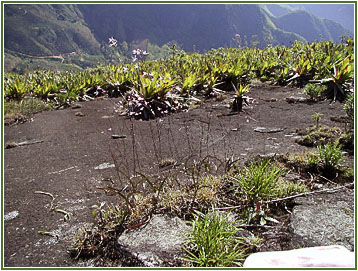
Pseudolaelia
brejetibensis |
they
are new, some are really different. Near to Colatina,
he found Pseudolaelia maquijiensis.
There is Pseudolaelia freyi, from Pedra Feia also
found near Venda Nova. There is the
miniscule Pseudolaelia pavopolitana, he
discovered it in the flanks of stone in Pavão village.
I think they are different. He also described Pseudolaelia
brejetibensis. He is doing a serious work.
Two months ago, we climbed Serra do Caraça, because he
didn't know Pseudolaelia irwiniana. All the habitat
was blooming. He found the
yellow Pseudolaelia
citrina at Venda Nova do Imigrante, on the
rocks, only in this place.
|
ON: The state of Espírito Santo is rich in this genus.
WZ: We also have the famous Pseudolaelia
canaanensis described by Ruschi as Renata canaanensis.
It is the biggest, it is really big, in our place, in Pedra
Azul, it spread and formed a thicket on the rocks, like in the habitat.
ON:
You talked about Serra do Caraça, this is a very
interesting region, isn't it?
AZ: This is a place protected by the park and very interesting.
Besides the beauty, the region is very rich in rupicolous
species, such as: Laelia fournieri, Laelia kettieana,
Laelia flava, Laelia crispilabia, Laelia lucasiana (ostermeyeri)
and Laelia macrobulbosa. In a same trip, we found
five blooming species. |

Caraça
Sanctuary
|
|
|
Laelia
kettieana |
Wladyslaw
at Laelia kettieana habitat |
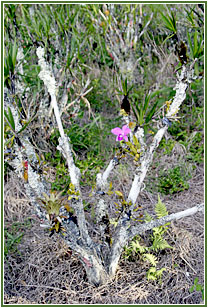
Flagstone
at Pedra Azul.
Photo:Sergio Araujo |
ON: You should have precious observations about habitats
and seems that you apply this knowledge in your ranch in
Pedra Azul.
WZ: Many observations. In Pedra Azul,
we had a rock where we planted more than 300 Vellozias.
Once, it was easy to bring them, nowadays is not possible.
We have Vellozia from Chapada Diamantina, from Serra do
Cipó, from Ouro Preto. It is a big flagstone which we transformed
in a habitat with many orchids. It is a very beautiful place,
looks like the nature, if someone takes a picture and says
that it is Serra do Sincorá, the biggest expert would not
say if it is true or not. Laelia sincorana has already
formed enormous thicket on the Vellozias and is reproducing
by itself as well as Sophronitis brevipedunculata,
Cattleya porphyroglossa which, in Nova Era, grows
on the Vellozias. Here,
in Viana, all things are still recent but in Pedra Azul
is much more beautiful
|
ON: What could you add about Laelia sincorana habitat?
WZ: Laelia sincorana grows in the
sertão (backwoods) of the state of Bahia, at about 1.000/1.200m
altitude, blooming at the end of September and earl October. In
the nature, in 90% of the cases, it grows on the Vellozias, just
on the top of the mountains, where there is a concentration of
humidity and clouds with a precipitation of humidity and ventilation
very strong. The ventilation is really strong in this region.
Laelia sincorana occurs on the . tepuis, tablelands
of the mountains where grow the giant Vellozias with more than
2.000, 3.000 years, I suppose. It completely covers those plants,
receiving strong ventilation, high luminosity and environmental
humidity., mainly during the night. It is the only way to cultivate
this species well and we should respect this when we cultivate
our Laelia sincorana on captivity. We should point out
that, in the same altitude
(1.200m), here, in Espírito Santo, the climate is
completely different. There,
in the sertão of Bahia, it is much more hot, so
much so if you bring a sincorana direct from there to Pedra Azul,
at the beginning, it will resent a lot and should be cultivated
in a acclimate greenhouse.
ON: This comparison about temperature
in the different regions at the same altitude is interesting...
WZ: It is also valid for another regions,
the temperature at 800m altitude in Colombia doesn't correspond
to the temperature, here, in the same attitude. Everything depends
on the place.
AZ: For example, the line of permanent snow is 4.000m, at the
ecuador line level. In Patagonia is 700m, 800m. Besides, for sure,
the sunstroke is completely different, high luminosity all year
around, without variation from summer to winter.
ON: That information about habitats are very useful for who wants
to have an appropriate cultivation. Often, the growers do exactly
the contrary to the plant needs, different from what occurs in
the nature, although, of course, it is impossible to copy the
nature because there are several factors. Coming back to Laelia
sincorana, in spite of talking about the difficult of the
immediate adaptation in high altitude, Espírito Santo, you cultivate
it at Pedra Azul?
WZ: Yes, we cultivate it in Pedra Azul,
at 1.100m. The first ones brought
from the nature, at
the beginning, they suffered a lot and took time to be
recovered, three or four years. However, those reproduced by seeds,
grow well, without any problems
ON: Do you think that those reproducing from seed could be
well adapted in Viana, at 300m?
WZ: Possibly yes but I think that Pedra
Azul is better although it has a climate a little bit more rigorous
concerning the temperature.
ON: And about Cattleya species habitats in Bahia such
as Cattleya elongata and Cattleya tenuis?
WZ: Cattleya elongata and Cattleya
tenuis come from a lower place, they never appear in the same
region as Laelia sincorana. While sincorana grows on
the Vellozias, on the top
of the mountains, in Chapada Dimantina, elongata grows below,
at about 800m altitude, on the rocks but we should point out that
the stone is arenitic, not granitic, so it assimilates much more
humidity.
ON: So this is the explication because since it is a bifoliate
Cattleya, it should have troubles with retaining humidity.
This kind of rock is not the same as we have in our region?
WZ: Ours is granitic, it doesn't work. The
arenitic is porous and when it rains, it assimilates much humidity
and releases it gradually to elongata roots. The elongata also
mingles itself to small shrubs where it has a certain protection
from the sun and the roots don't stay expose. It also has a certain
protection by the lays of vegetal material which are accumulate
on the rocks. The big concentration of the species stay along
the rivers and the biggest one is in Mucugê, along the Sandália
Bordada river. Those are true gardens, it is something spectacular
to see during the blooming period.
ON: And Cattleya tenuis, it has the same conditions
or it comes from a drier region?
WZ: It comes from a drier region, it is
located in the center of the state. During the dry period, the
creeks stay dried but during
the rain period, it rains a lot. Cattleya tenuis grows
at the confluence between the ground and the beginning of the
tree. It is half shade protected because the region is so dried
that the trees lose their leaves. It is more or less the same
condition of Cattleya
nobilior amaliae, in Tocantins, in "Azuis"
region. There, during the blooming season, September/October,
the trees stay completely leafless, so we can see those thickets
of nobilior, growing in the crotch of the bared trees.
ON: During the winter, Cattleya nobilior is under a
completely sunstroke ? Without rains?
WZ: Totally, a 100% and no rains at all
so much so that Cattleya nobilior amaliae is very susceptible
to the rain during the winter, it doesn't bloom well.
ON:
And about Cattleya schofieldiana habitats?
WZ: I know many
habitats here in Espírito Santo and Bahia, until Porto
Seguro, Arraial da Ajuda, everything is schofieldiana
and they are most beautiful I have seen. Those from Espírito
Santo have bigger flowers, the petals drop as they were
donkey's ears. Those from Bahia, no, they are all well
dispose however we also have some plants with more compact
flowers, petals well formed in a small region at Domingos
Martins. Those are the most beautiful schofieldianas in
Espírito Santo. The blooming season are different but
it is the same species.
|
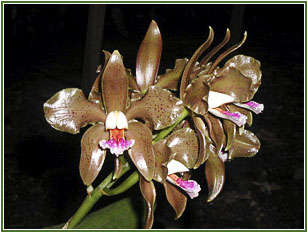
C.
schofieldiana 'Jubarte' |
ON: Those conditions are the same as Cattleya schilleriana
habitat?
WZ: Unlike schilleriana, it grows in the
woods a little bit more shade, in general, where there are internal
rocky formation because if the wood is completely closed, without
enough luminosity, it doesn't appear. It grows on the trees in
places with a high environmental humidity.
ON: And the cultivation?
WZ: In general, we can say that all those
Cattleya bifoliate are plants which require a special care
to be repotted because they don't have a store organ in their
pseudobulbs. In the nature, all of them are connected, in a way
or another, to some source of humidity but none of them likes
to have the roots buried. Cattleya schilleriana, Cattleya schofieldiana,
Cattleya harrisoniana, Cattleya guttata, Cattleya acklandiae
need a small stub, high environmental humidity, strong ventilation
and humidity because if it happens that a pseudobulb wrinkles,
it will never be covered. It is not the same as with the monofoliate
Cattleya, if Cattleya warneri wrinkles the pseudobulb
by lack of water, when we provide water, it will swell and the
plant will be recovered.
ON: And Cattleya velutina?
WZ: It is the same thing.
ON: Can it still be found in the habitats?
WZ: Not too many but we can find something.
Nowadays, it is considered as almost extinct in the nature. It
occurs in Espírito Santo, in Domingos Martins region, at
800m altitude, it means, higher than Viana, but lower than Pedra
Azul.
AZ: It grows on high trees.
WZ: On high trees and on the very top of
the trees, in the middle of the wood where they received strong
luminosity, strong ventilation and humidity coming from the ground
of the wood.
ON: But it is considered as a difficult plant even in the nature.
WZ: Look: in the nature, it is very endemic,
it is not spread through the whole state, so it is adapted to
a certain climate, in a certain region. If we take off and we
don't reproduce that climate, it can not resist.
ON: You said it is endemic but there is an occurrence in the
state of São Paulo.
WZ: In São Paulo, there is a variety,
with white lip, called 'paulista' (which means comes from São
Paulo).
ON: It will not be exactly the same which occurs in Espírito
Santo?
WZ: It is not exactly as ours, I also found
a velutina in Campo Redondo, in Chapada Diamantina, at the Serra
do Sincorá.
ON: It is a new information!
WZ: It is news, I found there, is identical
to our except for the blooming season.
ON: May be because of the different climate.
WZ : It happens, from here to Chapada Diamantina
there are 1.200 km. There we found three small plants that I thought
it was a Cattleya porphyroglossa, however when it blooms,
it was a velutina.
ON: By the way, Cattleya porphyroglossa is an unfamiliar
and rare cultivated species. It could be because of the flowers
which never open entirely?
WZ: They do, the only thing is the narrow
lip which has not the appearance of a velutina, schilleriana,
acklandiae, amethystoglossa, but it is a beautiful plant.
ON: And about its habitats?
WZ: I visited one in Bahia, in Serra do
Sincorá, at Chapada da Diamantina.
ON: Next to the river?
WZ: No. It was near the habitat of sincoranas,
while they occur on the top of the mountain, Cattleya porphyroglossa
grows bellow, in the plateau, at a tableland at 1.000m altitude.
The biggest concentration is in Nova Era, Minas Gerais, next to
Velhas rive where the mountains are granitic and there are many
vellozias which were completely covered with porphyroglossa. Thus,
people collected, collected and now, they only exist in inaccessible
places.
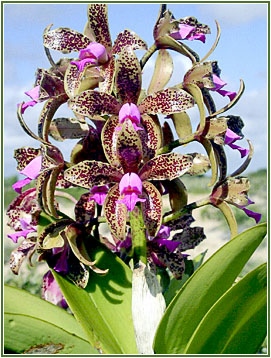 Cattleya
guttata
Cattleya
guttata |
ON:
And about Cattleya guttata and Cattleya leopoldii?
Do you consider as two different species? Still nowadays it
is very discussed.
WZ: People confuse those two species
very much. We can discuss but it is a personal question. People
considered that Laelia harpophylla and Laelia kaustky
are two different species, however they are much more
similar than guttata and leopoldii. Our Cattleya guttata
goes through the entirely state of Espírito Santo and moves
forward Rio de Janeiro. Some people say that it occurs until
the state of Rio Grande do Sul mixed with leopoldii. I don't
think so. In the south of Bahia, it is not guttata, it is
leopoldii. In my opinion, they are two different species.
ON: So in the south of Bahia and Pernambuco, you think it
is leopoldii?
WZ: Pernambuco I don't know but the
south of Bahia, I know, it is leopoldii. The scent is different,
the season of blooming is different al thought it doesn't
mean anything. |
Ours
is guttata, it has a narrower lip. We have a wonderful habitat,
in the sand, without any vegetal covering, with 15km longer
and 1km width, scrubs and scrubs of Cattleya guttata,
with 2 or 3 meter diameter. We are bring people from IBAMA
(our office of protection and preservation of nature) in
order to try to touch the major to see if he decides to
consider as an area of natural preservation. It is unbelievable,
you can walk all day long and see thousands and thousands
of flowers, in the sand.
|
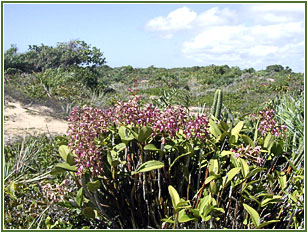
C. guttata habitats |
ON: In the state of Rio de Janeiro, we also
have Cattleya guttata in the sandbanks but people talk
about trunks and trunks full of plants to be sold.
WZ: Here, people started to do this, the
farmers don't want to see the place registered as an area of
preservation because it is connected to beach. It is 500m far
from the beaches and it is a land in boundaries of the farmers.
They are using as pasturage in order to deprive od the characteristics
of the place and avoid the register.
ON: From those trips, from the knowledge you got, from your
observation, what did you apply here, in the nurseries?
WZ: I always say that it is not the orchid
which becomes adapted to us. We should adapt ourselves to the
orchids. It is there, for millenniums, in that condition. It
has no reasoning, it has no good sense, it is up to us to approach.
In this case, it will thrive well.
ON: It means, it is a question of good sense of respecting.
Here you can see pseudobulbs of Cattleya schilleriana
and, even Cattleya violacea, Cattleya eldorado, rarely
seen.
WZ: Even in the Amazon, it is difficult
to see such well developed pseudobulbs of Cattleya eldorado
and violacea. That is the problem, the bifoliates
grow, more or less, in the same way. Cattleya violacea
is another plant that doesn't like to be buried, it should be
plant in small dried stubs, well watered and requires fertilization.
Greenhouse is not the nature, it is an artificial climate, we
should provide what the plant has in the nature and doesn't
find in the greenhouse. So it is fundamental to provide a correct
fertilization.
ON: What do you consider a correct fertilization? What do
you apply here?
WZ: We use a foliar feeding, it is not
radical, organic. The organic fertilization should be decomposed
to be absorbed by the plant, so there is no immediate absorption.
This decomposition is made by the bacteria and fungi, not even
all of them are beneficial for the orchids. It is also a kettle
of proliferation which can cause troubles to the plants. On
the other hand, this decomposition reaches also the substrate.
The plant has a very strong initial push but, if in the course
of the time, we take off the plant from the plastic pot, sometimes
with insufficient drainage, with a too much compressed substrate
and impregnated with organic fertilizers, we will see that the
root is black, it is also decomposed, so something is wrong.
As the growing is quite fast, the plant lives from the new roots
which arise from the last sprouts In fact, what does the orchid
assimilate? It is not the organic matter, it assimilates the
fertilizer obtained by the decomposition of the organic material,
the nitrogen, the phosphorus, potassium and all those micro-elements.
So, in my opinion, if we give the orchids already chewed pap
(it means the chemical fertilizer) with pure high quality salts,
they will assimilate immediately. Another thing, orchids are
even Ricinus’bran need to be decomposed to release nitrogen.
In the fertilizers sold in Brazil, the nitrogen comes from the
urea (40% of nitrogen) because it is one of the most cheap source
of nitrogen we have. And the commercial fertilizers, even though
called foliar, have, as a source of nitrogen, the urea and people
don't inform it in the directions. Also the urea is not immediately
assimilates by the plant , it should be decomposed, there are
already researches about this.
ON: So it is a double task for the plants.
WZ: Yes. The urea should be decomposed
to be assimilated by the plants. When we feed a plant with urea,
the urea is not in condition of offering nitrogen because it
is not still decomposed. Someone tells something funny: "when
we fertilize with urea, it is not in conditions of being assimilates
because it is not decomposed. If we water two days, the urea
drops on the creek, then on the brook, after than to the river
and finally on the ocean. Only there, it will be suitable to
our orchids".
ON: But, in this case, it has gone many times ago. And about
the foliar feeding we have on the market, do they also have
urea as a source of nitrogen?
How could we be sure about the source?
WZ: The most time yes, we should to research
the origin, to see the directions on the bottle. If it is not
there, ask the salesman or call the maker. Some people don't
accept this point of view and think that urea is good. As a
fertilizer to the ground, urea is excellent but it is not the
case of our orchid which
is, sometimes, just mounted in a small stub and should
assimilate immediately. In our case, we just use nitrogen fertilizer
- nitric and ammoniac composes - and never the urea. The assimilation
is immediate.
ON: Yes, when we see the vegetative conditions of your pants,
we have the impression that you are in the right way.
WZ: You can see by the conditions of our
plants... The plant arrives here and the pseudobulb double or
tripled.
ON:
Wladyslaw, the state of Espírito Santo as one of the most
rich state in Brazil, if not the most rich, concerning the occurrence
of the species, has also a quite rich history of orchidophilia.
You, along all those years you had an influence in this history.
Which is your influence in this history. Which is your role in
this and the foundation of the local society (Sociedade Espírito-santense
de Orquidofilia - SEO)?
WZ: We can consider that SEO started in
my home in Barro Vermelho, in Vitória, when a small group
of friends met here drinking wine and nibbling at cheeses and
discussing the formation of the society and the development of
the orchidophilia in Espírito Santo. The
society has been found in l992 and Euclidio Colnago was
the first president. Our meeting are free and SEO doesn't ask
for allowance. I have been President and always have the function
of technical director. Alek is our editor and does the monthly
technical newsletter for all associates.
ON: And the regional branches? How many
exist nowadays?
WZ:
There are eight branches until now:
ON: Thank you.
Photos:
AWZ Orchids, except when pointed out
Any
kind of reproduction (print, digital or anyone) of
any type of material of this site: texts, layout, photos,
images and others - is strictly forbidden without previous
written permission of the authors.
Any solicitation or information
should be done by the e-mil: bo@sergioaraujo.com |
|